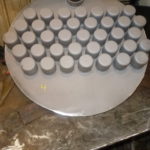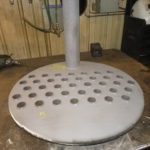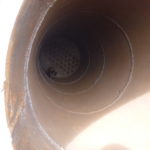Glycol dehydration using bubble cap style trays is currently the most popular, dependable, and economically efficient method to remove water from natural gas to meet pipeline and process specifications. This process involves bubbling wet gas upward through glycol that is flowing downward through evenly spaced trays. The gas gets drier as it passes upward through each tray. The tower is often also referred to as a glycol “contactor” or “absorber.” The most common type of glycol currently being used in this process is Tri-Ethylene Glycol (TEG) due to its high allowable temperature and dewpoint depression capabilities.
The bubble cap assembly consists of a cap and riser. The cap fits over the riser. Wet gas flows upward through the riser and is forced downward through the glycol and out through the slotted vent holes in the lower section of the cap.



Glycol is continuously draining down from the top of the tower into the subsequent trays through downcomer pipes. The downcomer inlet is located at an elevation that maintains a constant liquid level of about 2.5” in the tray and at a height that ensures that the bubble cap slots are always submerged. The outlet of the downcomer is located ¾” above the next lower tray and below its glycol level. When the water entrained (rich) glycol reaches the bottom of the tower, it goes through a heating process to remove its absorbed water. The dry (lean) glycol is then cooled and pumped back to the top of the tower to begin the cycle again.
 Aspire Energy Resources has over 20 years of experience providing remanufactured dehydration packages. The Aspire remanufacturing process entails full inspection and replacement of caps and trays where necessary to ensure trouble-free, “like new” operation backed by a 1-year warranty.
Aspire Energy Resources has over 20 years of experience providing remanufactured dehydration packages. The Aspire remanufacturing process entails full inspection and replacement of caps and trays where necessary to ensure trouble-free, “like new” operation backed by a 1-year warranty.
Our available inventory of used dehydrator packages can be seen and inquired about here: https://www.aspireenergy.com/equip_cat/dehydration-units/.
For more information about our products, please reach out to our team by calling 403-314-5422 or 1-800-993-9958. You could also contact us with any questions at https://www.aspireenergy.com/contact/.